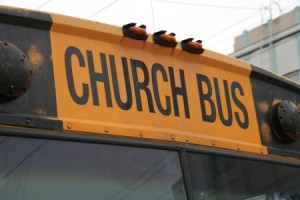Group Transport Safety Concerns for Church Organisations
December 4, 2012 - 4 minutes read If your church owns a large vehicle such as a bus to transport groups, it’s essential to take precautions in order to help ensure the safety of passengers in your care.
If your church owns a large vehicle such as a bus to transport groups, it’s essential to take precautions in order to help ensure the safety of passengers in your care.
The RACV defines buses as ranging from “10 seater minibuses to large coaches with a mass above five tonnes”. According to the RACV bus travel is in general considerably safer than commuting by private car in terms of risk of injury or death from accidents; however this does not eliminate or reduce the need for thorough vehicle inspections and maintenance, using or hiring only experienced and mature drivers, and being prepared for emergencies. Of course the same applies if a bus is hired for group-transport purposes.
Drivers:
- Make sure to engage drivers who are mature, responsible, experienced, and who hold the appropriate licence. In Victoria a LR (Light Rigid) or MR (Medium Rigid) licence may be required – see VicRoads (or your State’s road authority) for more information on this issue.
- On longer trips, employ more than one driver to share the load, and to reduce the risk of accidents from driver fatigue.
- Take steps to help prevent drivers from becoming distracted by passengers while the vehicle is in motion.
Seat belts:
- By law every occupant should wear a seat belt while riding in a bus if they are present. Many buses now have lap or sash belts installed.
Vehicle inspections to do before embarking:
- Oil, coolant and washer fluid levels.
- Battery.
- Tyre air-pressure and tread, and wheel lugs.
- Gauges, lights and indicators.
- Windscreen wipers, horn, fans and switches.
- Brakes.
- Check for loose connections, belts or wires, and check underneath vehicle for fluid leaks.
- Fire-extinguishers – make sure these are in place and undamaged.
Regular inspections and maintenance should also be done on the vehicle by a qualified mechanic.
Risky conditions, such as wet roads, fog, snow, or ice:
- Reduce speed, and maintain a longer distance from other vehicles.
- Use low beam in fog and snow.
- If visibility is low use the centre white line as a guide.
- Avoid jamming on or locking the brakes.
- Do not allow wheels to spin – if this occurs, pull back on the accelerator and try using a higher gear.
Emergency considerations – carry the following items:
- First Aid kit.
- Basic tool kit.
- Jumper leads.
- Torches and spare batteries.
- Tow ropes.
- Warning devices.
- For snow or ice – a bag of sand to aid traction, blankets, and spare warm clothing.
Emergency procedures should be set up to be followed in case of accidents. Considerations for this include contact numbers for emergency services and insurance providers, procedures for administration of First Aid, and record / note books and pens to take down notes and information. Make sure all drivers are trained and familiar with the emergency plan.
Other considerations:
- Do not overload any van or bus. Overloading increases the risk of blowouts and rollovers, and can make maneuvering the vehicle more difficult.
- Ensure all luggage or cargo is properly secured.
- For transporting of disabled persons or children special care should be taken. Make sure your drivers, employees or volunteers are fully trained in handling these sorts of situations.
If the vehicle is insured with CCI, see the ‘Making a claim’ section on the website for contact and claim information if required.
Written by Tess Oliver
Tags: Driving, health & safety, travel
Recent Comments